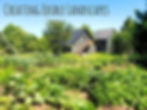Creating Edible Landscapes
- Heather
- Feb 12, 2022
- 4 min read
Updated: Mar 6, 2024
Long before I became a small-scale farmer, I was a forager. It didn’t matter where I lived, I foraged. When you start looking for food, you quickly discover it grows everywhere (at least in the Midwest)! In fact, many “weeds” that grow freely around us (often in spite of our efforts to eradicate them – think dandelions), are nutritionally superior to what you may find in the grocery store.

At our first house in the UP of Michigan, we were lucky to have an old apple orchard within a few minutes walk that also had several amazing blackberry patches nestled in the overgrown fields. Every summer and fall I happily harvested enough blackberries and apples to get us through the coming winter. These foraging excursions even helped get me through the final year of my doctoral program since they provided much needed (and physically active) breaks while writing my dissertation.
When we moved to Duluth after grad school, I was pleasantly surprised to find raspberry bushes, cherry trees, apple trees, and thimbleberries all growing within a couple blocks of our home. I was astonished that so much fruit went unpicked right in plain sight of so many homes and passersby.
I initially began gardening as a way to supplement my foraging. My first couple attempts at gardening were not successful but I persisted simply because of another hobby – converting existing lawn space into something more useful. I find I only need a small amount of well designed lawn and greatly dislike the hassle of maintaining large lawns, especially when they are only walked on to mow them.

Prior to starting Apple Acres Farm, I enjoyed converting low-value lawn space into fruit, vegetable or native plant gardens. I always designed these new spaces with an eye to future inhabitants. I would hate for someone to ripe out or seed over these garden spaces, so I tried to balance the garden layout with right-sized lawn space. This has included planting fruit trees that I knew we would never get a single fruit from. I have no problem paying it forward in the hopes that whoever comes along after us will enjoy the fruits of our labor!
Creating edible landscapes not only provides food and enjoyment for humans, it also increases biodiversity. In the eyes of most wildlife, a traditional monoculture lawn is a food desert. Once we began to let spaces go a little wild or add more plant diversity, it is amazing how quickly life returns. This is especially true for gardens and spaces that we allow to be a little messy and stop trying to tame natural processes.
Getting Started Creating Edible Landscapes
It can be a lot of fun to create an edible landscape! It can also be as easy or as hard as you want to make it. At the most basic level, you can simply stop mowing an area and you will likely find a return of a variety of edible and nutritious plants and flowers (aka weeds). Some of my favorite wild edible plants are dandelions, red clover, plantain, purslane, heal all, wild strawberry, curly dock, and yarrow. I use them in salads, teas and tinctures – either fresh or dried.

Back in Duluth when I converted our rather boring urban yard into an edible landscape, I approached it very intentionally. This was especially important because I knew my projects would take more than a season to complete. I also started working in our backyard that while visible to the neighbors, wasn’t as exposed as our front or side yards.
Over time I found that despite the unconventional and often messy nature of our transforming yard, our neighbors were intrigued by my projects and many stopped by to ask about what I had going on. It was a great way to get to know more people and expose them to an alternative to the conventional urban grass yard or uninspired formal plantings.
For areas that I stopped mowing, I made it a point to mow a very clean edge as well as to plant a few wildflowers. We never had any complaints because it was obvious that we weren’t neglecting these areas. Overtime along with the taller grasses, a variety of wildflowers grew back and we usually had something flowering in this area during the growing season.
Gardens or fruit trees can also be used to add character and privacy – and these don’t have to be confined to the backyard! We used our side yard in Duluth to build a rain garden right next to the sidewalk that the neighbors loved! The various native wildflowers and grasses attracted a variety of pollinators, including monarch butterflies.

There is no right or wrong way to create an edible landscape. Nothing is permanent! If you gradually create your spaces, you can also make adjustments as you go and gain more experience. If you are new to gardening, start small with just a couple new plants each year.
Looking for Inspiration?
If you are ready to right-size your lawn and create your own edible landscape, there is no wrong time to start! Winters are great time for dreaming about and designing your project, but don’t shy away from jumping in during the growing season if you are inspired.
Don’t forget to check out gardening books from your public library. There are always plenty of books on growing annual vegetables, but I particularly like to read books on forest gardening, permaculture, medicinal herbs, mushrooms, etc. Your imagination is your only limitation when it comes to creating edible landscapes.
If you are interested in seeing our current projects, I would encourage you to follow us on Instagram.
Happy growing!

